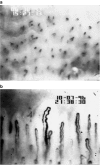Capillaroscopy and the measurement of capillary pressure
- PMID: 11136289
- PMCID: PMC2015012
- DOI: 10.1046/j.1365-2125.2000.00278.x
Capillaroscopy and the measurement of capillary pressure
Abstract
Capillaries play a critical role in cardiovascular function as the point of exchange of nutrients and waste products between the tissues and circulation. Studies of capillary function in man are limited by access to the vascular bed. However, skin capillaries can readily be studied by the technique of capillaroscopy which enables the investigator to assess morphology, density and blood flow velocity. It is also possible to estimate capillary pressure by direct cannulation using glass micropipettes. This review will describe the techniques used to make these assessments and will outline some of the changes that are seen in health and disease.
Figures





References
-
- Michel CC. Starling: the formulation of his hypothesis of microvascular fluid exchange and its significance after 100 years. Exp Physiol. 1997;82:1–30. - PubMed
-
- Levick JR. An introduction to cardiovascular physiology. London: Butterworth and Co Ltd; 1991. ISBN 0-750-61028-X.
-
- Koller A, Sun D, Kaley G. Role of shear stress and endothelial prostaglandins in flow- and viscosity-induced dilation of arterioles in vitro. Circulation Res. 1993;72:1276–1284. - PubMed
-
- de Wit C, von Bismarck P, Pohl U. Mediator role of prostaglandins in acetylcholine-induced vasodilation and control of resting vascular diameter in the hamster cremaster microcirculation in vivo. J Vascular Res. 1993;30:272–278. - PubMed
-
- Tang T, Joyner WL. Differential role of endothelial function on vasodilator responses in series-arranged arterioles. Microvascular Res. 1992;44:61–72. - PubMed
Publication types
MeSH terms
LinkOut - more resources
Full Text Sources
Other Literature Sources

